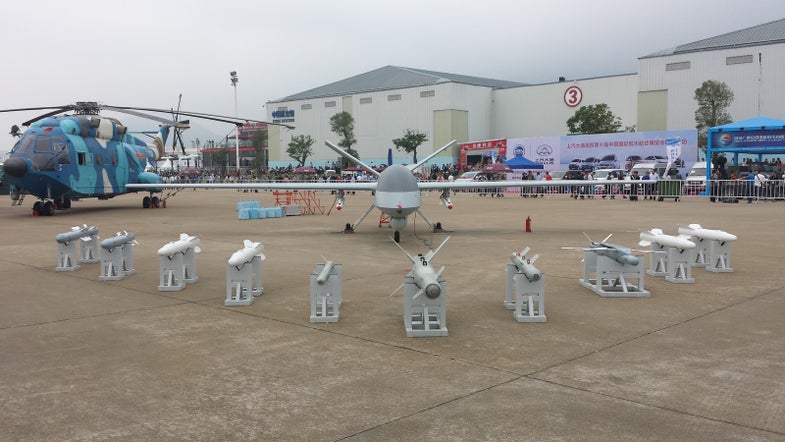China Shows Off Its Growing Drone Fleet
While much of the buzz at the Zhuhai Air Show has been about new manned stealth Jets in China’s arsenal,...


Zhuhai 2014
While much of the buzz at the Zhuhai Air Show has been about new manned stealth Jets in China’s arsenal, it has also shed light on how China’s unmanned aerial vehicle (UAV), aka “drone,” industry is making large strides.

GJ-1
The Aviation Industries Corporation of China (AVIC) showed off its GJ-1 UCAV, along with development drones like the VD-200 and Blue Fox.

WJ-1
Fresh off its Peace Mission 2014 debut, the CJ-1 proudly stands behind a wide variety of Chinese guided rockets, anti-tank missiles and glide bombs. “GJ-1” is actually the in service designation of the Pterodactyl UAV, which made defense headlines by dropping anti-tank missiles during the multilateral Peace Mission 2014 exercise. As China’s first UCAV, it is already being exported to Middle Eastern countries; China is less stringent that the U.S. when it comes to exporting lethal unmanned technologies.

Sharp Eyes III
Sharp Eye III drone copter is a NORINCO product, intended for use at the brigade/regimental level. A small to medium helicopter drone, it is primarily used for targeting artillery strikes and patrol, though like most UAVs, it could be armed with light weapons, like the BRM1 90mm guided rocket.

WJ-600

Old WJ 600
Target drones and decoy UAVs have not captured public imagination the way the hunter killer drones like the US Predator class has, but going back to the early Cold War, they fulfill some of the oldest unmanned aerial missions. CASIC’s WJ 600 Stealth UCAV is shaped like a cruise missile, with stealthy characteristics including a recessed turbofan engine to reduce its radar cross section. While the WJ-600 could simulate stealthy cruise missiles like the U.S. LRSAM during Chinese training, its manufacturer states it can perform missions like combat surveillance, targeting and patrol. Interestingly, a less stealthy version of the WJ-600 was shown at Zhuhai 2010, armed with antitank missiles. The 2010 iteration of the WJ-600 was the star of a CGI video showing it somehow attacking an U.S. Arleigh Burke class destroyer.

Blue Fox
AVIC’s Blue Fox UAV is a smaller, unmanned version of the L-15 advanced jet trainer; it has two turbojet engines with a total of 12 tons of thrust. The Blue Fox can simulate the flight performance of modern fighter jets during surface to air missile testing, though it shouldn’t take too much to use it as a supersonic UCAV once afterburners are added.

VD 200
The 200kg VD-200 VTOL is another interesting Chinese UAV. It takes and lands in a vertical position, but flies in an horizontal direction for 6-8 hours with 20kg of sensors, or small bombs. The VD-200’s small footprint would make it a very good fit for urban infantry and maritime security ships that would like to have a RQ-7 sized UAV.

S-100 Sea UAV
Speaking of water operations, the S-100 UAV is fully buoyant, meaning that it is a drone that can take off and land on water like a manned seaplane. Shanghai UVS Intelligence Systems Co notes that the S-100 can fly for 8 hours and carry a very large payload of 240 kg. In addition to serving as the eyes of maritime and naval patrol ships, the S-100 could provide a convenient UCAV capability for waterborne Chinese special forces.

VTAS Aerostat
China Electronics Technology Corporation is marketing its aerostat family; a 1,600 cubic meter version of the VehicularTethered Aerostat System is on display at Zhuhai. The 16m long aerostat reaches an altitude of 1,000 meters and is intended for law enforcement purposes, as well as being resistant to typhoon strength winds. The largest of CETC’s aerostats, with a volume of 8,000 cubic meters, can stay up for 30 days. The larger aerostat would probably have military missions by using their high altitude to detect low flying cruise missiles over hundreds of miles.

Harrier III
Harrier III drone concept is also a past Zhuhai attendee, having appeared in 2012 and other Chinese trade shows since then. While it resembles flying wing drones like the X-47B and RQ-170, it uses two propellers to more efficiently operate at lower speeds. The Harrier III has a heavy payload of 700 kg, compared to its overall weight of 2 tons. The Harrier III can say aloft for 24 hours, its endurance wouldmake it a valuable intelligence gathering and “high value target” strike platform.

Sharp Sword
You may be interested in:
China’s New Military Robots Pack More Robots Inside, Starcraft Style
Chinese Autonomous Tanks: Driving Themselves to a Battlefield Near You?
Are Weaponized ‘Crab Walker’ Robots the Future of Chinese Land Wars?
“Da Gou”, China’s Own Big Dog Robot
Pterodactyl Drones in Chinese Air Force Service
The New Inflatable Chinese Drone: Battlefield Balloons?
Not a Shark But a Robot: Chinese University Tests Long Range Unmaned Mini Sub